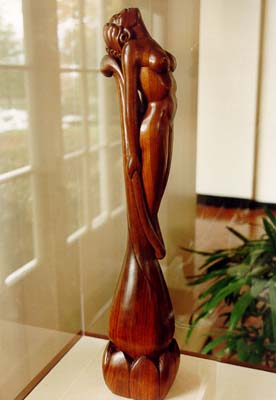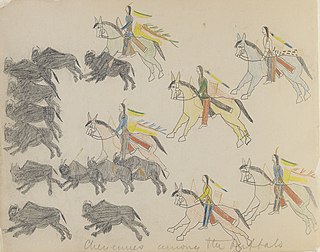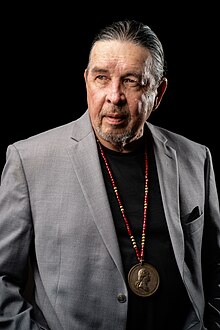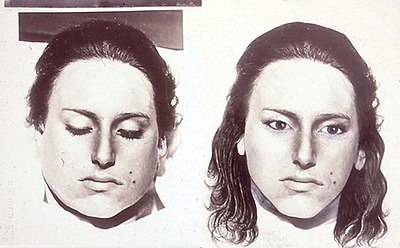
Guthrie is a city and county seat in Logan County, Oklahoma, United States, and a part of the Oklahoma City Metroplex. The population was 10,191 at the 2010 census, a 2.7 percent increase from the figure of 9,925 in the 2000 census. First known as a railroad station stop, after the Land Run of 1889, Guthrie immediately gained 10,000 new residents, who began to develop the town. It was rapidly improved and was designated as the territorial capital, and in 1907 as the first state capital of Oklahoma. In 1910, state voters chose the larger Oklahoma City as the new capital in a special election.

Joe A. Rector was born in Muskogee, Oklahoma. He is a part of the Cherokee ancestry. He lived in Muskogee and Tulsa, Oklahoma for most of his life, until his retirement. Afterwards, he moved to Destin, Florida, to live near his children until the time of his death in 2012.

Forensic art is any art used in law enforcement or legal proceedings. Forensic art is used to assist law enforcement with the visual aspects of a case, often using witness descriptions and video footage.
The Oklahoma Girl Scout murders took place on the morning of June 13, 1977, at Camp Scott in Mayes County, Oklahoma, United States. The victims were three Girl Scouts, between the ages of 8 and 10, who were raped and murdered. Their bodies were then left on a trail leading to the campsite's showers, about 150 yards from their tent. The case was classified as solved when Gene Leroy Hart, a local jail escapee with a history of violence and rape, was arrested. However, Hart was acquitted in March 1979 after a jury unanimously returned a verdict of not guilty.

David Pendleton Oakerhater, also known as O-kuh-ha-tuh and Making Medicine, was a Cheyenne warrior and spiritual leader. He later became an artist and Episcopal deacon. In 1985, Oakerhater was the first Native American Anglican to be designated by the Episcopal Church as a saint.

Ledger art is narrative drawing or painting on paper or cloth, predominantly practiced by Plains Indian, but also from the Plateau and Great Basin. Ledger art flourished primarily from the 1860s to the 1920s. A revival of ledger art began in the 1960s and 1970s. The term comes from the accounting ledger books that were a common source of paper for Plains Indians during the late 19th century.
The Cheyenne and Arapaho Tribes are a united, federally recognized tribe of Southern Arapaho and Southern Cheyenne people in western Oklahoma.

Willard Stone was an American artist best known for his wood sculptures carved in a flowing Art Deco style.

Edgar Heap of Birds is a multi-disciplinary artist. His art contributions include public art messages, large scale drawings, Neuf Series acrylic paintings, prints, and monumental porcelain enamel on steel outdoor sculpture.
Walter Richard West Sr., was a painter, sculptor, and educator. He led the Art Department at Bacone College from 1947 to 1970. He later taught at Haskell Institute for several years. West was an enrolled citizen of the Cheyenne and Arapaho Tribes.
The Bacone school or Bacone style of painting, drawing, and printmaking is a Native American intertribal "Flatstyle" art movement, primarily from the mid-20th century in Eastern Oklahoma and named for Bacone College. This art movement bridges historical, tribally-specific pictorial painting and carving practices towards an intertribal Modernist style of easel painting. This style is also influenced by the art programs of Chilocco Indian School, north of Ponca City, Oklahoma, and Haskell Indian Industrial Training Institute, in Lawrence, Kansas and features a mix of Southeastern, Prairie, and Central Plains tribes.

Carl Sweezy (1881–1953) was a Southern Arapaho painter from Oklahoma. He painted individual portraits, but was best known for his portrayals of ceremonies and dances.

Howling Wolf was a Southern Cheyenne warrior who was a member of Black Kettle's band and was present at the Sand Creek Massacre in Colorado. After being imprisoned in the Fort Marion in Saint Augustine, Florida in 1875, Howling Wolf became a proficient artist in a style known as Ledger art for the accounting ledger books in which the drawings were done.
Tichkematse, also called "Squint Eyes" or Quchkeimus (Cheyenne), was an artist and collector who worked for the Smithsonian Institution in Washington, DC between 1879 and 1881.
Les Berryhill is a Native American artist focusing on beadwork. He lives in Edmond, Oklahoma and is a member of the Yuchi and Muscogee tribes.
Merlin Little Thunder is a Southern Cheyenne artist living in Tulsa, Oklahoma. His paintings express the history, people, and the land in a narrative, representational style, especially from the perspective of the Southern Cheyenne people. He is known for his miniature paintings, bright colors, and for the incorporation of humor into his work.

Southern Plains Indian Museum is a Native American museum located in Anadarko, Oklahoma. It was opened in 1948 under a cooperative governing effort by the United States Department of the Interior and the Oklahoma state government. The museum features cultural and artistic works from Oklahoma tribal peoples of the Southern Plains region, including the Caddo, Chiricahua Apache, Comanche, Delaware Nation, Kiowa, Plains Apache, Southern Arapaho, Southern Cheyenne, and Wichita.

Oscar Brousse Jacobson was a Swedish-born American painter and museum curator. From 1915 to 1945, he was the director of the University of Oklahoma's School of Art, later known as the Fred Jones Jr. Museum of Art. He curated exhibitions and wrote books about Native American art.
The Center of the American Indian (CAI) was an intertribal, Native American-led museum in Oklahoma City, Oklahoma. It was housed in the second floor of the Kirkpatrick Center.

Bear's Heart was a Cheyenne ledger book artist who was one of 72 Native Americans to be imprisoned in 1875 at Fort Marion, in St. Augustine, Florida. While imprisoned, he created a series of drawings on ledger book pages using ink and colored pencils. In November 1876 he created a set of drawings known as the Bear's Heart Ledger Book.













